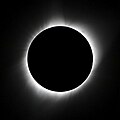This article includes a list of references, related reading, or external links, but its sources remain unclear because it lacks inline citations .(February 2025) |
| Total eclipse | |
| Gamma | 0.8893 |
|---|---|
| Magnitude | 1.0214 |
| Maximum eclipse | |
| Duration | 93 s (1 min 33 s) |
| Coordinates | 47°42′N8°12′W / 47.7°N 8.2°W |
| Max. width of band | 156 km (97 mi) |
| Times (UTC) | |
| Greatest eclipse | 10:10:01 |
| References | |
| Saros | 133 (22 of 72) |
| Catalog # (SE5000) | 8536 |
A total solar eclipse occurred on March 7, 1598 (25 February 1597 using the Old Style date). [1] A solar eclipse occurs when the Moon passes between Earth and the Sun, thereby totally or partly obscuring the image of the Sun for a viewer on Earth. A total solar eclipse occurs when the Moon's apparent diameter is larger than the Sun's, blocking all direct sunlight, turning day into darkness. Totality occurs in a narrow path across Earth's surface, with the partial solar eclipse visible over a surrounding region thousands of kilometres wide.



